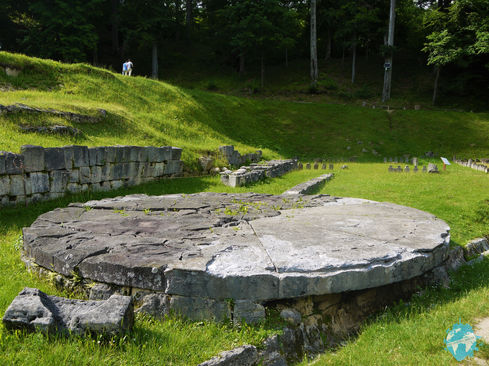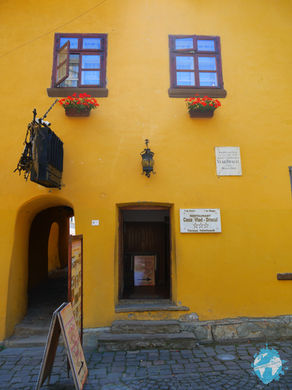
South Western
Road Trip
This itinerary takes you past waterfalls and rivers, through mountain tops and mines, and many of the region's most historic towns. It is a great option to explore some of the lesser-known areas of Romania and avoid driving through big cities like Bucharest. We drove this route in 6 days which is what we would recommend at the very least. It can be sped up by a day but you will reduce your leisure time or cut out some hidden gems.
Itineraries
Locations to visit
Other Countries
Travel Day 1
While we started in Sibiu this was designed as a loop tour so it can be started at any of the points. We suggest starting in Sibiu as the town has many rental car companies but is located far enough away from major hubs that we found it to be cheaper than the big cities. Sibiu is also quite small so you should not have much of an issue with traffic when you are trying to get used to the rules on the road.
Sibiu is one of the few cities that was pretty much left alone during Ceaușescu mass country redevelopment. This leaves it with a car-free city centre full of walking streets, colourful churches, watchtowers, and more eyes then you can imagine! Most buildings have unique shaped windows on their roofs which look exactly like eyes. Each is different so wander around town to see which set are your favourite! You can read more about the city HERE.
After picking up your car, head west toward the Transalpina Highway, the oldest and highest mountain pass across the Carpathian Mountains. About halfway through the highway, once you have passed dozens of cute country towns complete with horse-drawn carriages, and countless hairpin turns, you will get to an intersection where you can exit the Transalpina. DO NOT TAKE THE EXIT! The best part of the highway is the last third as it avoids the valleys and climbs directly over the mountains. The views are amazing and the drive is a great time as long as you like to sit on the edge of your seat!
As an alternative, if you are lucky enough to be exploring Romania when the Transfăgărășan is open (roughly July - September) you can take that highway and meet up with this itinerary for a night's sleep in Targu Jui. The Transfăgărășan is Romania's most famous highway and is often listed as the most beautiful road in the world (even Top Gear agrees)! Targu Jui is one of the largest cities in the southwest of Romania, and thus a great spot to stop for the night. There are large grocery stores, shopping malls, and best of all, lots of budget accommodations. For those that have an extra night, Targu Jui is home to a number of Constantin Brancusi sculptures that are worth checking out.
Travel Day 2
The next day takes you south toward the Serbian border and to the Head of Decebalus. While it would probably draw more of a crowd if it was to be his actual head, this is the largest relief sculpture in Romania. Sitting overlooking the Danube river, Decebalus stands at 141 feet tall, a symbol of the Romanian strength and resilience against foreign invasion. Take a dip in the river and enjoy a quick bite in town. After spending some time head back north towards Băile Herculane. This is a great spot to spend a couple of hours soaking in the natural hot springs which have made the town famous for almost 2,000 years. With lots of restaurants, it is also probably the best spot to grab some lunch. If you are able to get a tour of the former Neptune baths, it is absolutely worth it. The exterior of the Baroque styled building is worth checking out even if you can't get inside. The building is a true testament to what the city once was and hopefully an indication of what it could be in the future if things continue to turn around for the city.

After a quick treatment, jump back onto the highway and alongside the Cheile Nerei-Beusnita National Park to check out one of Romania's most beautiful natural wonders. The moss-covered waterfall is absolutely stunning and worth a quick stop. Doing so also allows you to drive a much less travelled highway which takes you through quaint Romanian villages and farms. If you want to stretch your legs for a bit longer, you can pay to get into the national park entrance beside the falls and take a short 10-minute walk to the source of the Bigar Springs and a cave. Alongside the parking lot of the waterfalls, there are a number of food and drink stands in case anyone is in need of a coffee!
Depending on how long you have spent up to now, Resita is a nice spot to stop for the night. While it doesn't have much in terms of attractions, it does have quite a few places to stay and a couple of restaurants or grocery stores. Alternatively, you can head to Caransebes for the night.
Travel Day 3

Travel Day 3 takes you back east and completes your southern loop. This day has lots of history so it will be best to get going quite early in the morning or split it into two days if you are a history buff. The first stop of the day is the former Romanian Roman capital Sarmizegetusa.
When the Romans conquered the Dacians in the 2nd century AD they moved the capital to this site. Over the coming years, they built a major Roman city complete with an amphitheatre, numerous temples, and of course a bathhouse. The site is in ruins but is the best example of Roman influence in Romania. Just 40km up the road is Sarmizegetusa Regia, the capital and the main military, political, and religious centre for the Dacian empire. The Dacians developed a powerful empire during the last half of the 1st millina BC that spread throughout modern day Romania,
Moldova, and parts of Bulgaria, Hungry, and the Ucraine. Decebalus was the last leader and famous for uniting numerous tribes to fight against the Romans. Sarmizegetusa Regia was destroyed in 106 AD and torn down by the Romans in order to build their Romanian Capital thus only the framework is still around today. The major draw is the temple terrace complete with 9 temples including 2 rare circular ones. These circle temples were among the most important sites in the Dacian kingdom and are often called the Romanian Stonehenge.
After some time exploring the site and walking along the fortress walls, head towards Hunedoara to check out one of the most famous Romanian Castles. Corvin's Castle (also known as Hunyadi Castle) was originally built in the 15th century and is one of the largest castles in Europe. That being said, what you see now is a 19th-century restoration to which some artistic interpretations were taken. The castle is probably most famous for being the spot the Vlad the Impaler was held prior to his trail. It is said that the bloodthirsty ruler was almost driven crazy by the screams of other prisoners being eaten alive by bears and wolves.
Spanning the area that once acted as a bear filled moat, the wooden bridge takes you into a grand entrance fit for royalty. If you are all historied out, there are lots of places to lay your head down for the night. If you do, make sure to check out the gypsy neighborhood, where numerous ornate metal mansions have been built, and the city centre for a water and music show!
The last stop of the day is the town of Geoagiu-bai. Not only is the town steeped in history but the small-town life is very evident. Start with Romania's Oldest Christian Church (11th Century) and the 14th century protestant Church built with reused Roman Marble. After a quick visit, take a trip up the hill to numerous beautiful waterfalls, and a Roman bath that is about 2,000 years old! Quick tip- there is a youth hostel on the site of the two churches which is a great spot to stop for the night. Say hi to the caretaker, Silly and he will be happy to take you around if he has time. If a youth hostel is not your thing, there are a number of places to stay near the Roman baths, or in the city further up the highway of Sebes.
Travel Day 4
Today we head north to Alba Iulia and end up in Turda famous for its underground salt mine. When you arrive in Alba Iulia, you will instantly know why you have come to the city. Sitting in the middle is one of the largest and most incredible fortified cities you will ever come across. Set within a double-walled 6 pointed star the largest citadel in Romania unfolds complete with
museums, churches, palaces, and full tree-lined boulevards. While the citadel is famous for many reasons including the execution of Horea and Closca on a breaking wheel, it was home to the signing of the unification of greater Romania in 1918. Prior to this deal, Romania was split into a number of states ruled by other nations or self-governing. The union
re-established the borders that Romania once controlled under

the leader Decabaulus. Take your time exploring this massive citadel before heading out of town towards Turda.
In Turda, you should split your time between two attractions, the Turda Gorge and Salida Turda. Salida Turda closes at 5 PM every day so make sure you are able to arrive before 3:30 at the very latest. This salt mine has been used for thousands of years and produced great wealth for the region for the many years before modern refrigeration. There are numerous massive bell-shaped cavities that reach hundreds of feet into the ground that were excavated using only hand tools. Now, the site is home to not only an awesome underground amusement park and lake but a health spa due to the apparently healthy salty air! The salt is not cooking quality, so watch out for anyone trying to sell you on Turda cooking salt!
The Turda Gorge is a fantastic hiking spot that is relatively unknown outside of locals and rock climbers. Leaving Turda you drive for a couple KM's until you see the rock wall in front of you that has literally been cut in half. Sheer rock walls rise on both sides leaving a rushing river in the middle. The couple hour hike crosses the river on suspension bridges several times, as well as navigating a section where you need to hold onto a chain bolted into the rock cliff. Turda has lots of accommodations at all budgets, so it is a great place to call it a day.
Travel Day 5
Today you take a couple of hours and drive straight to Sighisoara to have a full day exploring the medieval citadel. This UNESCO World Heritage site was the home of Vlad Dracul and the birthplace of Vlad the Impaler (Dracula). While it is a very touristy town, there are lots of unique things to see including a gorgeous Saxon Cemetery, a covered staircase from 1642, and 9 watchtowers that still stand today that protected the city from invasion. For a well-located place to stay (with free parking!) check out Casa Sighisoara. You can easily add an extra night here as well if you have the time.
Travel Day 6
On the final day, you will have a short drive back to Sibiu to drop off the car. If you can make it work, we suggest checking out the fortified church in Biertan, another UNESCO site. There are also a few hiking trails that will provide you with panoramic views of the fortified church and the surrounding mountains.




.jpg)


































































